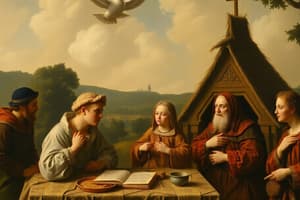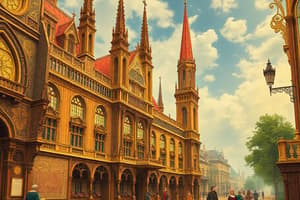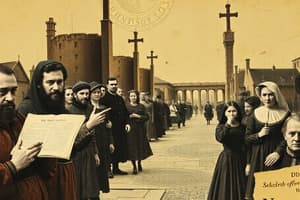Podcast
Questions and Answers
What was a key characteristic of the Renaissance?
What was a key characteristic of the Renaissance?
- The emergence of Protestantism
- The colonization of the Americas
- The rise of the Ottoman Empire
- The revival of classical learning and art (correct)
Who wrote the 95 Theses in 1517?
Who wrote the 95 Theses in 1517?
- Petrarch
- John Calvin
- Martin Luther (correct)
- Huldrych Zwingli
What was a major motivation for European exploration during the Age of Exploration?
What was a major motivation for European exploration during the Age of Exploration?
- The need to establish trade routes with Asia
- The quest for the Fountain of Youth
- The search for the Northwest Passage
- The desire to spread Christianity (correct)
Who led the first expedition to circumnavigate the globe?
Who led the first expedition to circumnavigate the globe?
What was a consequence of the Reformation?
What was a consequence of the Reformation?
What was a result of the Columbian Exchange?
What was a result of the Columbian Exchange?
Flashcards are hidden until you start studying
Study Notes
Renaissance (14th-17th centuries)
- Revival of classical Greek and Roman culture
- Emergence of humanism, emphasizing individualism and human potential
- Key figures:
- Artists: Leonardo da Vinci, Michelangelo, Raphael
- Writers: Petrarch, Boccaccio, Pico della Mirandola
- Characteristics:
- Revival of classical learning and art
- Development of perspective in art
- Emergence of city-states in Italy (e.g., Florence, Venice)
Reformation (16th century)
- Protestant movement against Catholic Church authority
- Key figures:
- Martin Luther (95 Theses, 1517)
- John Calvin (Institutes of the Christian Religion, 1536)
- Huldrych Zwingli (Swiss Reformation)
- Causes:
- Corruption and abuses within the Catholic Church
- Nationalism and anti-papal sentiment
- Consequences:
- Division of Western Christianity into Protestant and Catholic branches
- wars of religion (e.g., Thirty Years' War)
Age of Exploration (15th-17th centuries)
- European exploration and colonization of the Americas, Africa, and Asia
- Key figures:
- Christopher Columbus (first voyage, 1492)
- Vasco da Gama (route to India, 1498)
- Ferdinand Magellan (circumnavigation, 1519-1522)
- Motivations:
- Economic (trade, resources, and wealth)
- Religious (spread of Christianity)
- National pride and competition
- Consequences:
- Establishment of colonial empires (e.g., Spanish, Portuguese, British)
- Transfer of plants, animals, and cultures between hemispheres (Columbian Exchange)
- Impact on indigenous populations and ecosystems
Renaissance (14th-17th centuries)
- Revival of classical Greek and Roman culture led to a renewed interest in humanism, emphasizing individualism and human potential.
- Key figures of the Renaissance include artists Leonardo da Vinci, Michelangelo, and Raphael, as well as writers Petrarch, Boccaccio, and Pico della Mirandola.
- Characteristics of the Renaissance include the revival of classical learning and art, development of perspective in art, and the emergence of city-states in Italy, such as Florence and Venice.
Reformation (16th century)
- The Protestant movement was sparked by opposition to Catholic Church authority, led by figures like Martin Luther, who published the 95 Theses in 1517, John Calvin, who wrote the Institutes of the Christian Religion in 1536, and Huldrych Zwingli, who led the Swiss Reformation.
- Causes of the Reformation include corruption and abuses within the Catholic Church, as well as nationalism and anti-papal sentiment.
- Consequences of the Reformation include the division of Western Christianity into Protestant and Catholic branches, leading to wars of religion, such as the Thirty Years' War.
Age of Exploration (15th-17th centuries)
- European exploration and colonization of the Americas, Africa, and Asia was led by figures like Christopher Columbus, who made the first voyage in 1492, Vasco da Gama, who discovered the route to India in 1498, and Ferdinand Magellan, who led the first circumnavigation of the globe from 1519-1522.
- Motivations for exploration included economic gain through trade, resources, and wealth, as well as religious and nationalistic ambitions.
- Consequences of the Age of Exploration include the establishment of colonial empires, such as the Spanish, Portuguese, and British empires, the transfer of plants, animals, and cultures between hemispheres (Columbian Exchange), and a significant impact on indigenous populations and ecosystems.
Studying That Suits You
Use AI to generate personalized quizzes and flashcards to suit your learning preferences.




